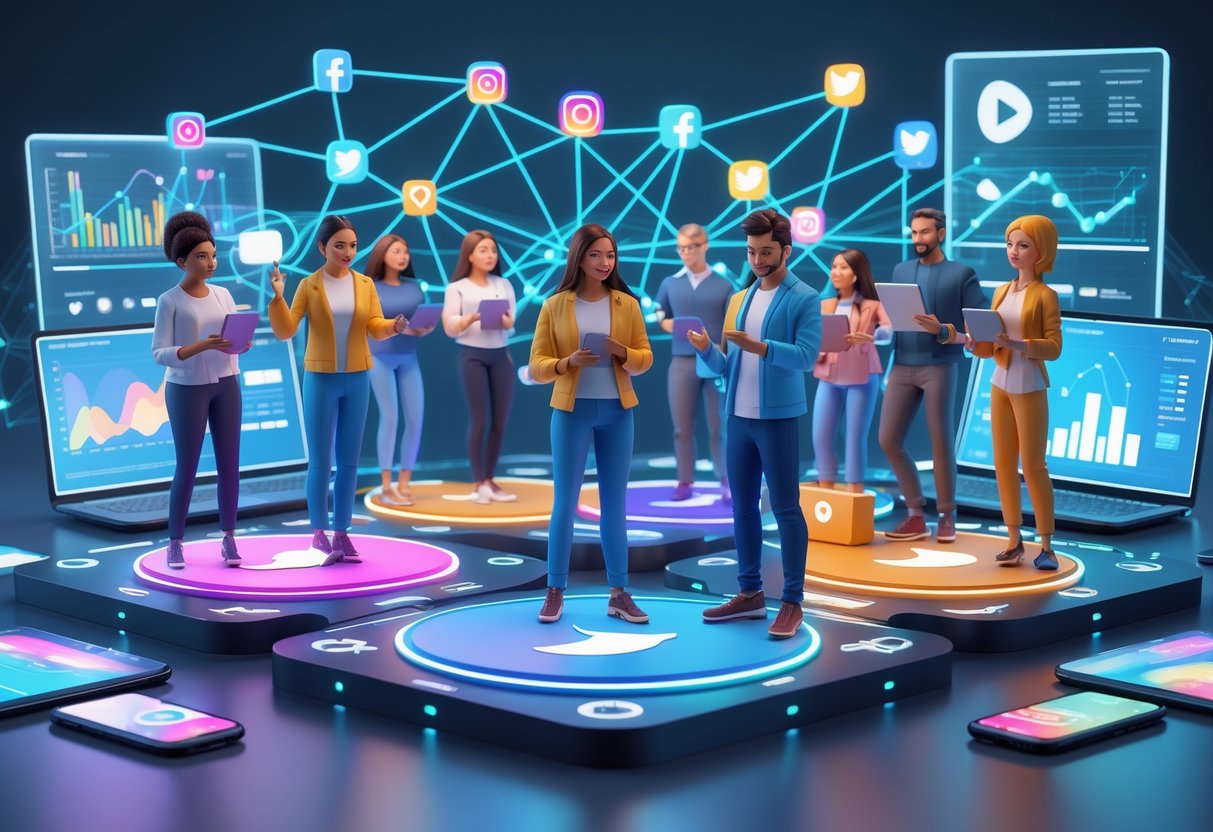Influencer Partnerships: Maximising Reach & Engagement in 2025
Updated On: October 24, 2025 by Aaron Connolly
Understanding Influencer Partnerships
Influencer partnerships bring brands and content creators together to promote products in a way that feels natural to audiences. These collaborations have pretty much become a staple in digital marketing now, giving brands authentic brand exposure while creators get new ways to make money.
What Are Influencer Partnerships?
A brand teams up with social media creators to promote products or services—that’s the core of an influencer partnership. These aren’t just one-off posts anymore.
Usually, the creator shares content about the brand across their channels. You’ll see things like unboxing videos, reviews, or maybe just a casual post showing off the brand’s gear.
Common partnership types include:
- Sponsored posts and stories
- Product collaborations and co-creation
- Brand ambassador programmes
- Affiliate marketing arrangements
Modern influencer partnerships lean into building lasting relationships. According to recent research, 79% of influencers now want ongoing brand deals instead of just one-off gigs.
The biggest difference from old-school ads? Authenticity. Followers genuinely trust the creators they watch. So when a creator recommends something, it just feels more like a friend’s advice than a pushy ad.
How Influencer Partnerships Differ from Traditional Marketing
Traditional marketing still relies on broad messaging—think TV, radio, or print. Influencer marketing, on the other hand, reaches people through voices they already trust.
Traditional marketing usually:
- Targets everyone at once
- Relies on polished, scripted messaging
- Cares about impressions
- Communicates one-way
Influencer partnerships give you:
- Niche, targeted audiences
- Conversational, authentic content
- Engagement-focused results
- Two-way audience interaction
The money side looks different too. Traditional ads need big upfront spends, and you’re never totally sure about the payoff. With influencer partnerships, you can start small and scale up if things work.
Influencer marketing also shifts creative control. Brands set guidelines, but creators keep their own style. This usually makes content that actually connects with people while still getting the brand’s message across.
Key Benefits for Brands and Influencers
Benefits for brands:
Brands get their stories out there in a way that feels real, reaching audiences they probably couldn’t reach otherwise. Creators introduce brands to followers who might never see a traditional ad.
Conversion rates go up because 63% of shoppers say they’re more likely to buy something if a trusted influencer recommends it. That trust really does move the needle.
It’s also just cheaper and more efficient. Micro-influencers especially offer good rates and bring in highly engaged followers.
Benefits for influencers:
Influencers find new ways to earn, from sponsored content to affiliate links and longer-term deals. For many, it’s become a full-time job.
They also get to grow professionally, sometimes even helping brands shape products or campaigns. Some creators end up as true business partners.
When creators share products they actually use, it adds value for their audience. People appreciate honest takes and real recommendations.
Mutual benefits:
Long-term partnerships help both sides. Brands get a better sense of what audiences want. Creators become experts on the products, making their content even more convincing.
Types of Influencer Partnerships
Gaming brands usually work with influencers in three main ways, each with its own level of investment and control. Affiliate partnerships pay creators based on sales, product gifting sends out free samples to build goodwill, and sponsored content pays for specific deliverables.
Affiliate Partnerships
Affiliate marketing lets gaming brands team up with streamers and creators without paying upfront. Influencers earn commissions when their followers buy products through special links or codes.
Commission rates usually fall between 5% and 30% for gaming gear. High-ticket items like chairs or monitors pay less, while digital products sometimes pay more.
This setup works well for smaller esports brands on a budget. You only pay when you get results, so it’s a low-risk way to test things out.
Popular platforms:
- Amazon Associates for gaming gear
- Twitch’s affiliate programme for subscriptions
- Brand-run programmes for gaming peripherals
Many gaming influencers build steady income streams through affiliate partnerships. They’ll promote products they actually use on stream or in videos.
Key benefits:
- No upfront spending
- Payments based on performance
- Easy to track results
- Works with all kinds of content
Product Gifting and Sampling
Product gifting is pretty straightforward—brands send free gaming products to influencers, but there’s no promise the creator will post about it. It’s all about building a relationship and letting creators try things out.
Gaming brands often send new releases to streamers and YouTubers. Sometimes creators make unboxing videos or reviews, or maybe the product just shows up in their regular content.
Common gifts:
- Headsets and keyboards
- New games
- Gaming chairs and desks
- Branded merch
This method works best with micro-influencers who have tight-knit communities. They’re more likely to talk about products they get.
Product sampling is a bit different—brands send samples and ask for feedback or a review. There’s a gentle nudge to create content, but no formal payment.
You have to pick influencers whose audiences fit your brand. If someone streams racing games, they probably won’t sell many puzzle games.
Advantages:
- Cheaper than sponsored content
- Builds ongoing relationships
- Feels more authentic to audiences
- Helps spot brand ambassador potential
Sponsored Posts and Content
Sponsored content means brands pay influencers a set amount to create specific promotional materials. This model gives brands the most control over what gets posted.
Payment structures vary:
- Flat fees from £50 up to £10,000+ per post
- Cost-per-thousand views (CPM)
- Packages covering multiple posts or platforms
Brands usually send over a brief with key messages, hashtags, and disclosure rules. UK law says sponsored content needs to be clearly marked with #ad or #sponsored.
Common sponsored content:
- Gameplay sessions featuring certain games
- Product review videos with talking points
- Social posts showing off gaming setups
- Stream overlays and banners
This guarantees content gets made and lines up with marketing plans. But honestly, if it feels too scripted, audiences might tune out.
Best practices:
- Give creators some creative freedom
- Pick influencers who fit your brand’s vibe
- Set clear deliverables and timelines
- Keep an eye on engagement and feedback
The best sponsored content blends naturally into the influencer’s usual style, while still spotlighting what makes the product cool.
Choosing the Right Influencers
Finding the right influencers isn’t just about who has the most followers. It’s way more important to look at engagement rates and whether their audience matches your goals.
We need to decide if nano-influencers or micro-influencers are a better fit, and then see if their communities line up with our target market.
Nano-Influencers vs Micro-Influencers
Nano-influencers (1,000-10,000 followers) often have a personal connection with their audience. That trust usually means better engagement.
They’re great for local esports events or super niche gaming communities. Many are happy with product exchanges or smaller fees.
Micro-influencers (10,000-50,000 followers) have more experience working with brands. They know the ropes when it comes to content and campaigns.
Their followers are still engaged, just not quite as close-knit as nano-influencers. You’ll pay more—typically £200-£500 per post.
| Influencer Type | Followers | Engagement Rate | Cost Range | Best For |
|---|---|---|---|---|
| Nano | 1K-10K | 7-12% | £50-£200 | Local campaigns, niche audiences |
| Micro | 10K-50K | 4-8% | £200-£500 | Broader reach, professional content |
Selecting Influencer Tiers for Your Campaign
Pick influencer tiers that match your campaign goals. If you want app downloads, micro-influencers can drive action through comments and saves.
Brand awareness? Mix it up—a macro-influencer for reach, and a bunch of micro-influencers for engagement.
Budget matters, a lot. You can work with 10 nano-influencers for the price of one micro-influencer.
Gaming campaigns do best with creators who actually play your game. Check their recent posts and streams to make sure.
Evaluating Audience Fit and Authenticity
Don’t just look at demographics—dig into engagement. Real followers ask questions and share posts.
Heads up: If you see sudden follower spikes or lots of generic comments, that’s a red flag.
Check if their audience matches yours. If a fitness influencer suddenly posts about gaming, their followers might not care.
Look at past brand deals too. If they’re always promoting competitors, your message might get lost.
Use analytics tools to check audience demographics, interests, and engagement. This tells you if their community fits your campaign.
Defining Campaign Goals and KPIs
You can’t run a successful influencer campaign without clear goals and measurable KPIs. If you don’t know what you’re aiming for, it’s impossible to track ROI or make smart changes.
Setting Clear Objectives
Set specific, realistic goals before you start. These guide which influencers you pick and what you track.
Brand awareness goals might mean growing mentions by 30% or reaching 500,000 new viewers in your target group.
Engagement objectives focus on interaction. Maybe you want a 5% engagement rate or 1,000 comments on campaign posts.
Conversion goals tie straight to business. You could aim for 250 new sign-ups or £10,000 in sales through affiliate links.
Community building is about the long game—like adding 2,000 new Discord members or boosting your social following by 15%.
Make sure your goals fit your bigger marketing picture. If you’re launching a new esports title, focus on awareness. For established games, conversions probably matter more.
Key Performance Indicators for Success
Pick KPIs that actually track your goals. The right numbers help you see what’s working and tweak your campaigns on the fly.
Reach and impressions:
- Total campaign impressions
- Unique reach numbers
- Cost per thousand impressions (CPM)
Engagement:
- Likes, shares, comments
- Video completion rates
- Click-through rates (CTR)
- Saves and bookmarks
Conversions:
- Website traffic from influencer links
- Sign-up rates
- Sales from campaigns
- Cost per acquisition (CPA)
Don’t go overboard—track 3-5 KPIs per campaign. Focus on your main goal, but keep an eye on a few extra numbers for context.
Set benchmarks that make sense. In gaming, engagement rates usually sit around 1-3%, but micro-influencers can do better in tight-knit esports circles.
Strategic Influencer Collaboration
The best influencer partnerships go way beyond basic product placements. They build real connections between brands and audiences by leaning into genuine storytelling and working together on creative content.
Co-Creating Authentic Content
Brands shouldn’t control every detail of sponsored content anymore. The best influencer collaborations let creators keep their own style while weaving in brand messages naturally.
Micro-influencers with 10,000 to 100,000 followers often get better results than mega-influencers. Their audiences actually trust what they say because it feels more personal.
You’ll want to find creators whose content already fits your brand values. A fitness influencer who actually uses your protein powder will make more convincing content than someone just reading a script.
Give creators space to be creative, but set clear brand guidelines. Share your brand story and core messages, then let them tailor the content for their followers. This way, it comes across as real, not forced.
Try offering several content formats in one partnership. An Instagram post, a Stories series, and a YouTube video each hit different audience moments.
Brand ambassador programs work especially well for long-term, authentic content. When creators feature your products over months, their fans start to connect your brand with someone they trust.
Leveraging Storytelling for Brand Impact
Stories spark emotional connections that product shots just can’t. Brands should encourage influencers to share real experiences and honest reactions, not just generic promos.
The most interesting sponsored content blends products into a creator’s usual storylines. A tech reviewer might slip your gadget into their monthly roundup, while a lifestyle blogger works your service into their daily routine.
Word-of-mouth marketing thrives when influencers share both the good and the not-so-good. Balanced reviews build trust with audiences who notice when something feels too salesy.
Ask creators to show how your product solves a real problem. Let them demonstrate how it fits into their lives or helps them reach a goal. This makes the content more relatable and useful.
User-generated content campaigns boost storytelling even further. When influencers get their followers to share their own experiences, you get a bunch of authentic moments and social proof.
Focus on engagement quality, not just numbers. Meaningful comments and real conversations show your story is connecting, not just skimming the surface.
Building Long-Term Relationships

Brands see deeper trust when they move from quick campaigns to lasting partnerships. If you invest in ongoing relationships, the results usually beat those from one-off creator posts.
From One-Off Campaigns to Ambassadorships
Switching from single collaborations to brand ambassador programs takes some planning. Start by picking creators who share your brand’s mission and values.
One-off campaigns help you test the waters. But they don’t build the trust that comes from repeated exposure. When fans see their favorite creator use your brand again and again, it feels authentic.
Here’s how the transition usually goes:
• Check performance from your first campaigns
• See if audiences match between creator and brand
• Negotiate longer deals with clear expectations
• Offer milestone rewards for hitting goals
Creators get more creative freedom with ambassadorships. They learn your products inside out, and that knowledge shows up in their content.
Ambassador programs usually last 6-12 months. That’s enough time for relationships to grow, but it still leaves room for flexibility.
Maintaining Engagement Over Time
Long-term partnerships can get stale if you don’t manage them well. Keep things fresh by switching up content types and celebrating milestones together.
Regular check-ins make a difference. Try scheduling monthly calls with top creators to talk about how things are going and what’s next. These chats build real connections, not just business deals.
Performance-based incentives help keep creators motivated. Offer bonuses for smashing engagement targets or hitting conversion goals.
Your engaged audience grows when creators genuinely connect with your brand over time. People spot true enthusiasm versus forced plugs.
Some key ways to keep things lively:
• Rotate content formats (posts, stories, videos, live streams)
• Give exclusive access to new products or events
• Celebrate partnership anniversaries with special rewards
• Invite creative input on product ideas
Track engagement metrics every month. If numbers start dropping, work with creators to tweak their approach instead of pulling the plug right away.
Maximising Brand Awareness and Exposure

Influencer partnerships open up audiences that brands just can’t reach with old-school ads. The right creative campaigns can turn casual viewers into loyal customers and build real trust in gaming communities.
Reaching New Audiences
Esports influencers give brands instant access to hyper-engaged gaming fans. These folks usually ignore traditional ads, but they listen to their favorite streamers and creators.
Different influencer tiers do different jobs. Nano-influencers (1K-10K followers) connect with tight-knit communities. Their followers often know them personally and trust their word.
Micro-influencers (10K-50K followers) balance reach with authenticity. They have enough followers to make a difference, but still keep things personal.
Macro-influencers (500K+ followers) deliver huge brand exposure, but engagement drops. Their reach is wide, but not as deep.
| Influencer Tier | Follower Range | Best For | Engagement Rate |
|---|---|---|---|
| Nano | 1K-10K | Niche products | 7-10% |
| Micro | 10K-50K | Balanced reach | 3-7% |
| Macro | 500K+ | Mass awareness | 1-3% |
Gaming brands get the most by working with a mix of tiers. That way, you get both big reach and real engagement.
Creative Campaign Formats
Giveaways still crush it for brand awareness in gaming circles. Teaming up with streamers for hardware or game giveaways can spike engagement fast.
Set up giveaways the right way. Make following your brand and sharing content part of the entry. This spreads your reach beyond just the influencer’s followers.
Sponsored gameplay sessions are perfect for gaming hardware brands. People see the products in action, not just in an ad.
Behind-the-scenes content builds deeper bonds. Show how gear holds up during practice or tournaments for genuine brand exposure.
Tournament sponsorships plus influencer partnerships multiply your impact. The influencer promotes your brand while competing, reaching both their fans and the tournament crowd.
One quick tip: Multi-platform campaigns win. Get influencers to post across Twitch, YouTube, and social media to reach every corner of your audience.
Measuring ROI and Campaign Effectiveness

You need to track your esports influencer partnership success with precise financial and engagement metrics. Smart measurement helps you spot what’s working and make better decisions for future campaigns.
Analysing Performance Data
ROI calculation is where it all starts. Divide the revenue you make by the campaign cost to find your return percentage.
If you spend £10,000 and make £25,000 in sales, that’s a 150% ROI. Use unique discount codes and affiliate links to track direct sales.
Key performance indicators (KPIs) depend on your goals:
• Brand awareness: Reach, impressions, brand sentiment
• Engagement: Comments, shares, video completions
• Sales: Conversion rates, average order value, customer lifetime value
The engagement rate shows how much people interact with sponsored content. Just divide total engagements by reach and multiply by 100.
Industry benchmarks help you see how you’re doing. Esports content typically hits 3-6% engagement on Instagram and 8-15% on TikTok.
Attribution tracking proves what’s working. Use UTM links and special landing pages. Watch for website traffic spikes during campaigns.
Track metrics at different times. Engagement usually pops in the first 24-48 hours, while sales might take a week or two.
Improving Future Campaigns with Insights
Performance analysis shows you what to tweak. Compare which content types, posting times, and influencer profiles work best.
Gameplay tutorials often beat static posts in esports deals. Live streams usually get more engagement than pre-recorded videos.
Audience insights help you pick the right influencers next time. Look at who drove real traffic and engagement, not just big numbers.
Demographics matter a lot. If you’re targeting 16-24 year-olds on mobile esports, TikTok creators usually outperform YouTubers.
Cost efficiency analysis helps you spend smarter:
| Metric | Calculation | Insight |
|---|---|---|
| Cost per engagement | Total spend ÷ engagements | Content resonance |
| Cost per acquisition | Campaign cost ÷ new customers | Sales efficiency |
| Cost per mille (CPM) | Spend ÷ (impressions ÷ 1000) | Reach effectiveness |
Don’t just document wins—note what flopped, too. Failed campaigns teach you just as much.
A/B testing different ideas inside campaigns sharpens future results. Try out creator styles, content types, and calls to action.
Build scorecards for each influencer partnership. Rate them on engagement, audience fit, and how easy they are to work with.
Legal and Ethical Considerations

Influencer partnerships come with rules. Brands and creators have to follow disclosure guidelines and agree on fair payment to protect everyone and stay compliant.
Disclosure and Transparency
Clear sponsorship disclosure is a must in ethical influencer partnerships. We have to label all sponsored posts, whether it’s a big campaign or a single post.
The Advertising Standards Authority (ASA) wants disclosure up front. Use #ad, #sponsored, or #paidpartnership at the start of posts—not hidden in a stack of hashtags.
For videos, say it out loud within the first 30 seconds. Just a simple “this video is sponsored by [brand]” usually covers it.
Commission-based deals need disclosure too. If you’re making money from affiliate links or sales, tell people right away.
Here’s what solid disclosure looks like:
| Platform | Best Practice | Example |
|---|---|---|
| #ad in first line | “#ad Loving this new headset from @brand” | |
| YouTube | Verbal + description | “Thanks to Brand X for sponsoring today’s video” |
| Twitch | Ongoing display | “!sponsor” command showing current partnerships |
| Clear hashtag | “#ad Just tried this energy drink” |
Heads up: Hiding sponsorships can lead to ASA investigations and a big trust hit with your audience.
Fair Compensation Practices
Fair payment keeps partnerships healthy and sustainable. Stick to industry rates instead of accepting every “exposure” offer.
Base your rates on engagement, not just follower count. Somewhere between £10-50 per 1,000 engaged followers is a good starting point for sponsored posts.
Commission rates should be clear and realistic. Most affiliate deals run from 3-10% depending on the product and order size.
Consider these payment models:
- Flat fee: One-time payment for content
- Performance-based: Pay for clicks, sales, or sign-ups
- Retainer: Monthly fee for ongoing work
- Product + payment: Free stuff plus cash
Always sort out usage rights before you start. Brands shouldn’t use your content forever without paying extra.
Quick tip: Make a rate card for your services. It speeds up negotiations and shows you’re professional.
Get it all in writing before you create anything. Include payment terms, content requirements, deadlines, and usage rights in your agreement.
Influencer Partnerships in Multi-Channel Strategies

Modern esports brands need influencers who can actually reach people across different platforms—from Twitch streams to TikTok highlights. Smart multi-channel strategies mix up where and how you collaborate to maximize both reach and engagement.
Integrating Social Platforms
Every social media platform pulls in a different slice of the esports audience and demands its own content style. Twitch dominates live streaming, but TikTok nails those viral highlight clips, and YouTube is the go-to for longer tournament breakdowns.
Brands get the best results when they match influencers to the platforms where they shine. For example, a skilled Twitch streamer might pull in 10,000 live viewers, yet only hit 500 views on TikTok.
Platform-specific content really makes a difference:
- Twitch: Live commentary, subscriber tournaments, real-time reactions
- YouTube: Tutorials, tournament breakdowns, gear reviews
- TikTok: Quick plays, funny moments, backstage clips
- Instagram: Team news, sponsor reveals, lifestyle shots
Just cross-posting the same thing everywhere? It usually flops. We suggest making content that feels like it truly belongs on each platform.
A lot of top esports partnerships use a “hub and spoke” system. The main content sits on one platform, and then brands share smaller, tailored snippets elsewhere to pull people back in.
Cross-Channel Collaboration
The best esports marketing campaigns bring in all sorts of influencers on different channels at once. That creates an “influencer ecosystem” that reaches way further than any single-platform deal.
Effective layering looks like this:
- Mega-influencers (1M+ followers) for huge reach
- Micro-influencers (10K-100K) for tight community engagement
- Nano-influencers (1K-10K) for genuine peer-to-peer recommendations
We’ve watched esports brands triple their engagement rates with this approach instead of just using one influencer. The trick is to coordinate timing and messaging so everyone’s on the same page.
Cross-channel strategies really shine during tournament seasons. One influencer might stream live on Twitch, while others handle predictions on Twitter or post-match analysis on YouTube.
To pull this off, you’ll need:
- Shared content calendars
- Brand messaging guidelines everyone understands
- Platform-by-platform performance tracking
- Frequent, honest check-ins between collaborators
Addressing Common Challenges in Influencer Partnerships

Clear communication and proactive planning stop most partnership problems before they can even start. Brands and influencers do well when they get expectations management right and steer clear of predictable pitfalls early on.
Managing Expectations
Setting clear boundaries from the start saves everyone headaches later. We always recommend a detailed brief covering deliverables, timelines, and creative guidelines before anyone starts making content.
Most mismatches happen because brands assume influencers just “get” their vision without a proper brief. The influencer then makes content that doesn’t fit, so brands ask for changes, and everyone gets frustrated.
Make sure you clarify:
- Content format and posting schedule
- Brand messaging requirements
- Visual style and tone
- Performance metrics and reporting
- Payment terms and deadlines
Letting influencers have creative freedom—within reason—tends to work best. Give them your guidelines, but let them talk to their audience in their own way.
Regular check-ins on longer campaigns catch problems before they become big. A quick call or message here and there works better than waiting for the final product.
Avoiding Partnership Pitfalls
The biggest marketing partnerships usually fail because brands chase follower counts instead of real audience fit. It’s a common mistake, especially when gaming brands team up with lifestyle creators who don’t actually speak to gamers.
Some pitfalls we help brands dodge:
| Problem | Solution |
|---|---|
| Fake engagement rates | Check comment quality and real followers |
| Budget overspend | Start small with micro-influencers |
| Legal compliance issues | Use disclosure tags like #ad or #sponsored |
| Weak tracking | Set up unique discount codes or links |
Dig into the influencer’s past brand deals. Look for genuine endorsements, not just obvious cash grabs.
We push brands to start with smaller test campaigns. One post or story can tell you a lot about whether there’s potential.
Watch audience reactions closely in the first day after content goes live. If you see negative feedback or weak engagement compared to their usual posts, the fit probably isn’t right.
Future Trends in Influencer Partnerships

New content formats are changing how brands reach gaming fans, and influencers are taking on much broader roles than just pitching products.
Emerging Content Formats
Interactive live streams are quickly becoming the gold standard in gaming partnerships. Instead of pre-recorded videos, brands now sponsor live tournaments where influencers compete alongside their fans.
Short-form vertical content rules on TikTok and Instagram Reels. Gaming influencers put out 15-60 second clips with gameplay tips, reactions, or product reviews.
Virtual reality experiences open up fresh partnership options. Brands sponsor VR gaming sessions where influencers naturally show off products as they explore virtual worlds.
Cross-platform campaigns let one partnership reach everywhere. An influencer might stream on Twitch, post highlights on YouTube, and share clips on TikTok—all with the same brand.
AI-powered content tools help influencers polish their material. Brands now expect higher production values, which means partnerships often include tech support and editing help.
Evolving Influencer Roles
Long-term brand ambassadorships are replacing single sponsored posts. Gaming influencers sign 6-12 month contracts and become real advocates, not just quick advertisers.
Co-creation partnerships bring influencers into product design. Gaming gear companies work with streamers to make custom keyboards, mice, and headsets based on their input.
Community management roles put influencers in charge of brand Discord servers and forums. They connect companies and gaming communities through direct engagement.
Performance-based deals tie payment to real results. Influencers get bonuses when their campaigns deliver sales or downloads, not just views.
Educational content casts gaming influencers as coaches. They team up with brands to produce tutorials, strategy guides, and training series for their fans.
Frequently Asked Questions

Brands usually ask about measuring campaign results, setting fair pay, and handling legal stuff. Knowing the strengths of each platform and trying creative engagement strategies makes partnerships smoother and helps avoid the usual traps.
How can brands effectively measure the success of collaborations with influencers?
Start by tracking engagement rates—likes, comments, shares, and views—on sponsored posts. That shows whether the content actually hits home with people.
Check website traffic and conversions for clear ROI. Use tracking links and promo codes to see who clicks through and buys during a campaign.
Keep an eye on follower growth and brand mentions across platforms. Did your follower count go up? Are people talking about you in comments and discussions?
Quick win: Set up Google Analytics goals before launching to track specific actions like sign-ups or purchases.
Compare your results to the goals you set for the campaign. Whether you wanted brand awareness or sales, see if you hit your targets.
Use analytics tools that show impressions, reach, and audience details. Many influencer platforms send automated reports with these stats.
What are some creative strategies for brands to engage with influencers?
Co-creating products leads to more authentic partnerships. Let influencers help design limited-edition items or give input on new products.
Behind-the-scenes content gives followers something special. Invite influencers to your offices, events, or production spaces for unique footage.
Challenge campaigns get users involved. Set up branded hashtag challenges that influencers can kick off with their fans.
Long-term ambassador programs build deeper relationships than one-off posts. Try quarterly or yearly deals with key creators.
Warning: Don’t over-script content. Let influencers keep their own voice, while sticking to your brand guidelines.
Cross-promotion boosts reach. Share influencer content on your own social channels and website.
Experiential partnerships make memorable content. Sponsor travel, events, or unique experiences that fit your brand vibe.
Could you suggest approaches for setting fair compensation in influencer partnerships?
Follower count gives you a starting point for rates. Nano influencers (under 10K) usually charge less than macro influencers (100K-1M).
Engagement rates matter more than just follower numbers. Someone with 50K really engaged followers often outperforms an influencer with 200K who barely gets likes.
Industry norms suggest £10-100 per 1,000 followers for sponsored posts, but rates change a lot based on niche, platform, and content style.
For smaller campaigns, consider non-cash rewards. Free products, exclusive access, or commissions can work for newer influencers.
Quick win: Offer flexible pay packages—base fees plus bonuses for hitting engagement or sales goals.
Think about content usage rights when setting rates. If you want to reuse content for ads, expect to pay extra for licensing.
Platform matters for pricing. YouTube videos usually cost more than Instagram stories because they take longer and last longer.
What criteria should companies consider when choosing the right influencer for their brand?
Start with audience fit. Does the influencer’s following match your target demographic in age, interests, and buying habits?
Check content quality and consistency. Scroll through recent posts for visuals, engagement, and brand fit.
Make sure your values line up. Look into the influencer’s past brand deals and public statements.
Engagement quality is more important than follower count. Look for real conversations, not just generic comments or spam.
Warning: Use fraud detection tools to spot fake followers or bought engagement before signing a deal.
Past brand partnerships show experience. Newer influencers might be cheaper but may lack campaign know-how.
Geography matters too. Local influencers can work better for events or businesses tied to a specific place.
What are the key legal considerations in forming influencer partnerships?
You must label sponsored content clearly. Influencers need to use #ad, #sponsored, or similar tags to follow advertising rules.
Define content usage rights in your contracts. Spell out if you want to reuse influencer content elsewhere.
Be clear about deliverables. Write out post timing, formats, hashtags, and approval steps in your agreement.
Include termination clauses. Cover what happens if the campaign goes off track or if you need to remove content.
Quick win: Use standard contract templates to cover common issues like missed deadlines or guideline slip-ups.
Influencers usually keep content ownership unless you say otherwise. Make sure you clarify who owns what up front.
Add liability clauses to protect your brand. Influencers should agree to follow platform rules and legal requirements.
How does the use of influencer collaboration platforms enhance campaign management?
You can find relevant influencers pretty fast with centralised discovery tools.
Advanced search filters let you narrow things down by demographics, engagement rates, or content categories.
Automated analytics make it easier to track performance.
These platforms pull together engagement data, reach metrics, and conversion stats into one dashboard.
Communication features help teams collaborate without endless back-and-forth.
Built-in messaging, content approval, and deadline tracking really cut down on admin headaches.
Fraud detection tools spot problematic accounts before you even start working with them.
Quality analysis flags suspicious engagement or fake followers so you don’t waste time.
Quick win: Try out platform free trials first—see which features and interfaces actually feel right before you pay.
Payment processing and contract management tools take a lot of the pain out of admin work.
Automated invoicing and standardised agreements mean less legal and financial hassle.
Campaign templates make future collaborations way faster.
You can save successful campaign structures and influencer lists to quickly launch similar projects next time.

